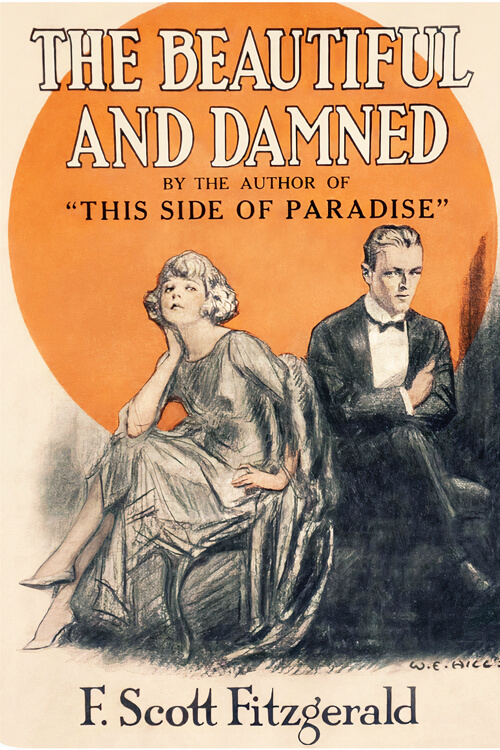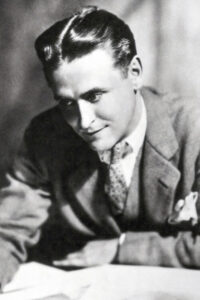
The Beautiful and the Damned
In 1913, when Anthony Patch was twenty-five, two years were already gone since irony, the Holy Ghost of this later day, had, theoretically at least, descended upon him. Irony was the final polish of the shoe, the ultimate dab of the clothes brush, a sort of intellectual “There!”—yet at the brink of this story, he has as yet gone no further than the conscious stage. As you first see him he wonders frequently whether he is not without honor and slightly mad, a shameful and obscene thinness glistening on the surface of the world like oil on a clean pond, these occasions being varied, of course, with those in which he thinks himself rather an exceptional young man, thoroughly sophisticated, well adjusted to his environment, and somewhat more significant than anyone else he knows.
This was his healthy state and it made him cheerful, pleasant, and very attractive to intelligent men and to all women. In this state, he considered that he would one day accomplish some quiet subtle thing that the elect would deem worthy and, passing on, would join the dimmer stars in a nebulous, indeterminate heaven halfway between death and immortality. Until the time came for this effort he would be Anthony Patch—not a portrait of a man but a distinct and dynamic personality, opinionated, contemptuous, functioning from within outward—a man who was aware that there could be no honor and yet had honor, who knew the sophistry of courage and yet was brave.
Read or download Book
F. Scott Fitzgerald
Francis Scott Key Fitzgerald (September 24, 1896 – December 21, 1940) was an American novelist, essayist, and short story writer.
Biography.
He is best known for his novels depicting the flamboyance and excess of the Jazz Age—a term he popularized in his short story collection Tales of the Jazz Age. During his lifetime, he published four novels, four story collections, and 164 short stories. Although he achieved temporary popular success and fortune in the 1920s, Fitzgerald received critical acclaim only after his death and is now widely regarded as one of the greatest American writers of the 20th century.
Born into a middle-class family in Saint Paul, Minnesota, Fitzgerald was raised primarily in New York state. He attended Princeton University where he befriended future literary critic Edmund Wilson. Owing to a failed romantic relationship with Chicago socialite Ginevra King, he dropped out in 1917 to join the United States Army during World War I. While stationed in Alabama, he met Zelda Sayre, a Southern debutante who belonged to Montgomery’s exclusive country club set. Although she initially rejected Fitzgerald’s marriage proposal due to his lack of financial prospects, Zelda agreed to marry him after he published the commercially successful This Side of Paradise (1920). The novel became a cultural sensation and cemented his reputation as one of the eminent writers of the decade.
His second novel, The Beautiful and Damned (1922), propelled him further into the cultural elite. To maintain his affluent lifestyle, he wrote numerous stories for popular magazines such as The Saturday Evening Post, Collier’s Weekly, and Esquire. During this period, Fitzgerald frequented Europe, where he befriended modernist writers and artists of the “Lost Generation” expatriate community, including Ernest Hemingway. His third novel, The Great Gatsby (1925), received generally favorable reviews but was a commercial failure, selling fewer than 23,000 copies in its first year. Despite its lackluster debut, The Great Gatsby is now hailed by some literary critics as the “Great American Novel”. Following the deterioration of his wife’s mental health and her placement in a mental institute for schizophrenia, Fitzgerald completed his final novel, Tender Is the Night (1934).
Struggling financially because of the declining popularity of his works during the Great Depression, Fitzgerald moved to Hollywood where he embarked upon an unsuccessful career as a screenwriter. While living in Hollywood, he cohabited with columnist Sheilah Graham, his final companion before his death. After a long struggle with alcoholism, he attained sobriety only to die of a heart attack in 1940, at 44. His friend Edmund Wilson edited and published an unfinished fifth novel, The Last Tycoon (1941), after Fitzgerald’s death. In 1993, a new edition was published as The Love of the Last Tycoon, edited by Matthew J. Bruccoli.
Born on September 24, 1896, in Saint Paul, Minnesota, to a middle-class Catholic family, Francis Scott Key Fitzgerald was named after Francis Scott Key, a distant cousin who wrote the lyrics in 1814 for the song “The Star-Spangled Banner”, which later became the American national anthem. His mother was Mary “Molly” McQuillan Fitzgerald, the daughter of an Irish immigrant who became wealthy as a wholesale grocer. His father, Edward Fitzgerald, descended from Irish and English ancestry and had moved to Minnesota from Maryland after the American Civil War to open a wicker furniture manufacturing business. Edward’s first cousin twice removed, Mary Surratt, was hanged in 1865 for conspiring to assassinate Abraham Lincoln.
One year after Fitzgerald’s birth, his father’s wicker furniture manufacturing business failed, and the family moved to Buffalo, New York, where his father joined Procter & Gamble as a salesman. Fitzgerald spent the first decade of his childhood primarily in Buffalo with a brief interlude in Syracuse between January 1901 and September 1903. His parents sent him to two Catholic schools on Buffalo’s West Side—first Holy Angels Convent (1903–1904) and then Nardin Academy (1905–1908). As a boy, Fitzgerald was described by his peers as unusually intelligent with a keen interest in literature.
Procter & Gamble fired his father in March 1908, and the family returned to Saint Paul. Although his alcoholic father was now destitute, his mother’s inheritance supplemented the family income and allowed them to continue living a middle-class lifestyle. Fitzgerald attended St. Paul Academy from 1908 to 1911. At 13, Fitzgerald had his first piece of fiction published in the school newspaper. In 1911, Fitzgerald’s parents sent him to the Newman School, a Catholic prep school in Hackensack, New Jersey. At Newman, Father Sigourney Fay recognized his literary potential and encouraged him to become a writer.






